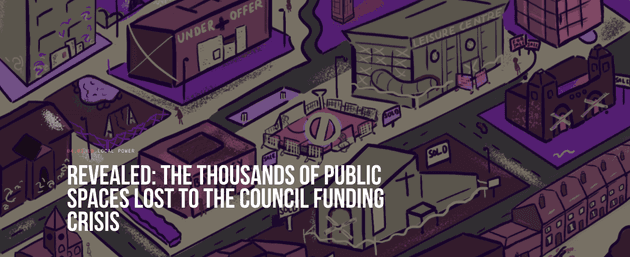How to build impact: a case study
We used our Local Power investigation to help spark change at a grassroots and national level
As I continue to develop a vision and strategy for how the Bureau’s work can consistently create change, it’s been great to see a recent example of our journalism making an impact. I want to talk about it here as an illustration of how taking our reporting out into the real world in targeted ways can yield powerful results that would simply not be possible through traditional journalistic output alone.
Gareth Davies, a Bureau Local reporter, and a network of almost 200 regional partners have spent more than a year investigating the financial crisis engulfing English councils. The resulting stories have demonstrated the devastating effect the cuts are having on public services and spaces.
Gareth’s work navigating reams of highly complex council budget sheets and the rules and regulations surrounding them, on top of hundreds of Freedom of Information requests, has given him an expertise I doubt any other journalist can boast.
The story development process was non-traditional, which made it richer. After collating the initial findings, Bureau Local brought together a wide range of experts on local government and services and asked them what under-reported topics we should be writing about. It proved a really useful exercise that went on to shape the coverage.
We also ran a day-long, collaborative reporting event in five cities to dig into our data with attendees including various universities, open data organisations, the Women’s Budget Group and the tech firm AQL.
It may sound niche on the face of it, but understanding this information and making it accessible is absolutely crucial for local democracy and accountability. With that in mind, we disseminated the investigation’s findings in several strategic ways. First, the most straightforward: they were turned into articles and blogs published on our website and by our national partner HuffPost UK. They were very well-read and picked up by other national media outlets. The Bureau Local’s network also meant that more than 100 regional stories were published with specific local angles.
 Some of the Bureau's stories from the investigation
Some of the Bureau's stories from the investigation

Second, we collaborated with Outlandish, a digital agency, and Far Nearer, the independent reporting project, to create an interactive, searchable map that allows anyone to see what spaces or buildings any council has sold, and for how much. If someone has more information on a particular sale, or details of a sale that is missing, they can fill in an online form and their submission will be verified and added.
This map turned months of research and thousands of documents that the average person would not have been able to find or scrutinise into an easy-to-use resource that keeps track of what public spaces are being lost to the council funding crisis.
Finally, this grassroots community impact has been complemented by top-down policy impact in the past two weeks. After Gareth’s investigations were published we discovered that the Housing, Communities and Local Government select committee was carrying out a review into the state and sustainability of council finances. The Bureau submitted Gareth’s findings as lengthy written evidence to the review in the specific format required by parliament.
We were the only journalistic organisation to contribute.
Last week the committee’s report was released and his findings were cited extensively, with some of the policy recommendations made by the MPs directly relating to issues raised in his evidence. Of more than 100 submissions made by various organisations and individuals, only 36 were cited in the report and only six were cited three times or more — including the Bureau’s.
By thinking carefully about how our journalism could best serve different target communities, and in what format those communities would be able to meaningfully engage with it, the work both informed national policy recommendations and was used by the public as a practical resource to keep track of taxpayers’ money.
I’ll be back with another case study soon which shows how journalism’s key function to tell human stories can be its greatest power - and how that can happen best face-to-face. In the meantime, get in touch if you have any inspiring examples to share!
Header image: Gareth Davies and members of the Bureau Local team. Credit: Juliet Nagillah




